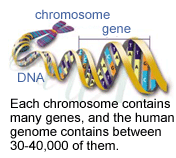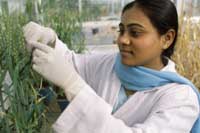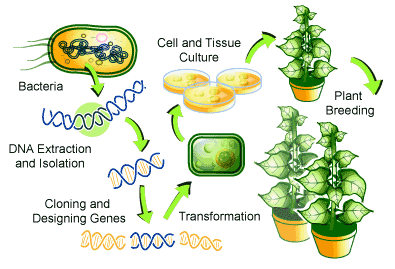



The code which regulates all biological processes is stored in the DNA present in every cell of living organisms.
Only a small share of the DNA in a cell actually makes up genes, which contain coded information. The cells use this information to produce proteins, the basic building blocks and tools for running biological processes.
The role of the remaining share of the DNA is not yet clearly understood. The DNA in cells is generally organized into pairs of corresponding chromosomes with one set of chromosomes being inherited from each parent. An organism's entire set of chromosomes, and thus its entire set of genetic information, is called the genome.
The Human Genome Sequencing Project has decoded the genetic information contained in human cells. The project has developed many technologies and methods that can be applied to all living organisms. Other large genome-sequencing projects rely on international collaboration to study certain plants such as rice, which are considered representative of their biological group. More...
2.2.1 The most significant breakthroughs in agricultural biotechnology are coming from research into the genetic mechanisms behind economically important characteristics and from genomics.
Genomics is the study of the complete structure of the genome. It provides information on gene structures and thus a basis for understanding protein structures. As a result, a theoretical model of an organism's biology may be built from a listing of its genes.
Comparing the relative location of genes on the chromosomes and DNA sequences in different organisms will significantly reduce the time needed to identify and select potentially useful genes. For most types of crops, livestock, and diseases, certain species have been studied as model species because they can be used to understand related organisms. Knowledge of the genome of model species is accumulating rapidly. More...
2.2.2 Different plant species tend to have a genome structure with very similar gene content and gene order along the chromosomes. This similarity is called "synteny". This means that the location of a gene which defines particular characteristics can easily be determined by comparing one genome to another. Therefore, it is not critical for our understanding to undertake the complete sequencing of plant genomes for all of crop plants with the great costs that this would entail.
As a consequence of synteny the knowledge of the biochemistry, physiology, and genes of a specific crop can now be transferred to other crops. This is particularly important in the case of so-called "orphan crops"; that are used in subsistence agriculture in many parts of the world. These crops have not attracted the research money that wheat, rice, and maize have received over the past century. More...
2.3.1 Molecular markers are specific fragments of DNA that can be identified within the whole genome. The markers are found at specific locations of the genome. They are used to ‘flag’ the position of a particular gene or the inheritance of a particular characteristic. In a genetic cross, the characteristics of interest will usually stay linked with the molecular markers. Thus, individuals can be selected in which the molecular marker is present, since the marker indicates the presence of the desired characteristic. More...
2.3.2 Molecular markers can be used to select individual plants or animals carrying genes that affect economically important traits such as fruit yield, wood quality, disease resistance, milk and meat production, or body fat. Measuring such characteristics by conventional methods is much more difficult, time-consuming, or expensive, since it requires the organism to grow to maturity. More...
2.3.3 Molecular markers have been used to select individual plants to create mildew resistant varieties of pearl millet, a cereal grown for foodgrain and straw in the hottest, driest areas of Africa and Asia. More...
2.3.4 Molecular markers are useful to measure the extent of variation at the genetic level, within and among populations. This can guide genetic conservation activities for crops and livestock, as well as forestry and fisheries.
For example, global surveys indicate that about 40% of domestic livestock breeds are at risk of extinction. Most of these breeds are found only in developing countries, and there is often little knowledge about them or about their potential for improvement. They may contain valuable genes that confer beneficial characteristics such as disease resistance that may be of use for future generations. Modern biotechnologies can help to counteract trends of genetic diversity loss in the food and agriculture sectors. More...
2.3.5 Molecular markers have been widely used to identify the genetic makeup of organisms and for obtaining their “genetic fingerprint”. Such knowledge can be very important in forest management, endangered species conservation, and livestock breeding and tracing. More...

2.4.1 Gardeners routinely make new plants simply by planting cuttings from existing ones. Micropropagation, making plants from small plant samples grown in test tubes, is merely a more sophisticated and efficient variant of this technique.
It is often a very effective way of producing very large numbers of nearly identical plants from one individual plant with desired characteristics. This technique is extensively used in hundreds of laboratories around the world for example for generating disease-free banana plants, and has potential applications in forestry. More...
2.4.2 For in vitro selection, plant cells are grown in laboratories under adverse conditions. This allows the selection of cells that, for example, are resistant to diseases or tolerant to herbicides, metals, salt, or low temperatures before growing the full plant. However, in vitro selection is still of limited use for some characteristics like wood quality or stem form in forest trees, since these characteristics only become apparent in fully grown plants. More...
Genetic engineering differs from conventional plant breeding. In conventional plant breeding half of the genes of an individual come from each parent, whereas in genetic engineering one or a few specially selected genes are added to the plant genome.
Moreover, conventional plant breeding can only combine closely related plants. Genetic engineering permits the transfer of genes between organisms that are not normally able to cross breed because they are not genetically compatible. The transferred genes are called transgenes. They can come from another plant species, or even from a completely different organism (e.g., bacterial genes). These transgenes are then replicated and inherited in the same way as natural plant genes.
Genetic engineering of plants usually makes use of a type of bacteria which has the natural ability to transfer DNA to some plants.

When the bacterium infects the plant, it penetrates the plants cells and transfers its modified DNA to the plant.
The DNA may also be introduced by physical means. Carried on microscopic particles of tungsten or gold, the DNA is literally shot into the plant nucleus, using a ‘gene gun’. Once the DNA reaches the cell nucleus, it inserts itself at random into one of the host chromosomes and can express the desired character. The genetically modified plant is then grown from the transformed cell.
A number of economically valuable characteristics have been introduced into plants by genetic engineering. Most of the genetically modified crop plants used so far have transgenes that provide resistance to herbicides or insects. To improve crop production and soil management, research is now exploring how to increase the variety of transgenic characteristics to include resistance to drought, heat, cold, acid soils, and heavy metals. These characteristics will increase the range of soils and climates that are able to support agriculture. More...
2.6.1 Transgenic plants can provide food with enhanced nutritional content. For example, genetically modified “Golden Rice” contains two daffodil genes and one bacterial gene that together result in elevated levels of provitamin A.
Another project involves producing rice with increased levels of provitamin A, protein, and iron. The "protato" is a genetically engineered potato which contains more protein than usual because it carries a gene from the edible South American amaranth plant. In India, where potato is the staple food of poor people, the protato could increase the availability of certain essential amino acids. Opponents of this project argue that potatoes do not contain significant amounts of proteins to start with, so even doubling the protein content would actually only make a small contribution to solving India's malnutrition problem.
Other projects aim to produce plant oils with lower levels of undesirable fatty acids or to reduce allergens in common foods such as peanuts, soybean, and cereals. Trees with a reduced lignin content would be useful for the pulp and paper industry and would lessen the amount of polluting chemicals used in the production processes. More...
2.6.2 In more than 30% of all arable land, primarily in developing countries, aluminium can be present in the soil in a form that limits plant growth. To prevent these harmful effects, the usual approach is to add lime to the soil to reduce its acidity. However, this measure is costly and its benefits are temporary, because the aluminium remains in the soil.
A new approach consists of developing new varieties of plants that are more tolerant to aluminium. For example, rye is four times more resistant to aluminium than wheat. A gene controlling aluminium tolerance in rye was identified and its position on the genome determined. Knowing the location of this gene in rye can help locate it in other crops such as wheat. Thus within a crop species individual plants which are more resistant than others to aluminium could be identified and selected for further breeding. Alternatively, the gene could also be transferred from rye to other closely related species such as wheat.
These techniques could be applied to improve many characteristics in other crop species. More...

This summary is free and ad-free, as is all of our content. You can help us remain free and independant as well as to develop new ways to communicate science by becoming a Patron!